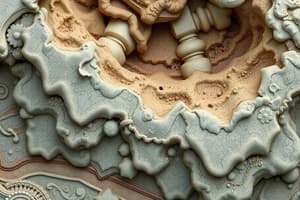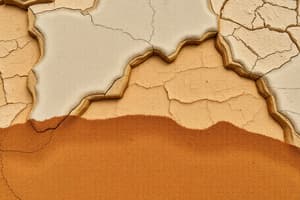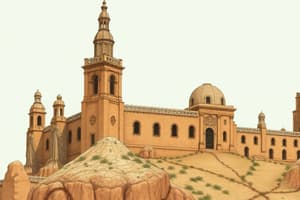Podcast
Questions and Answers
Which of the following sedimentary rocks is classified as a biochemical rock?
Which of the following sedimentary rocks is classified as a biochemical rock?
- Coquina (correct)
- Breccia
- Sandstone
- Conglomerate
Cross bedding indicates that sediment layers were deposited in a steady, uniform current.
Cross bedding indicates that sediment layers were deposited in a steady, uniform current.
False (B)
What is the primary composition of siltstone?
What is the primary composition of siltstone?
Quartz and clay
Bedding features like __________ can be used to determine the flow direction of past currents.
Bedding features like __________ can be used to determine the flow direction of past currents.
Match the following sedimentary rocks with their primary features:
Match the following sedimentary rocks with their primary features:
What is the most common feature of sedimentary rocks?
What is the most common feature of sedimentary rocks?
Graded bedding consists of layers where the particle size increases from bottom to top.
Graded bedding consists of layers where the particle size increases from bottom to top.
What is a characteristic of graded bedding?
What is a characteristic of graded bedding?
What type of sedimentary rock forms from previously living organisms?
What type of sedimentary rock forms from previously living organisms?
Cross bedding forms from layers of sediment deposited horizontally.
Cross bedding forms from layers of sediment deposited horizontally.
What type of sedimentary rocks are primarily formed from the remains of once-living organisms?
What type of sedimentary rocks are primarily formed from the remains of once-living organisms?
Sedimentary rocks are formed through the process of __________, which includes compaction and cementation.
Sedimentary rocks are formed through the process of __________, which includes compaction and cementation.
Which of the following best describes cross-bedding?
Which of the following best describes cross-bedding?
As sediment is transported, individual pieces become __________ due to collisions.
As sediment is transported, individual pieces become __________ due to collisions.
Clastic sedimentary rocks are primarily formed from the accumulation of mineral fragments and rock debris.
Clastic sedimentary rocks are primarily formed from the accumulation of mineral fragments and rock debris.
Match the sedimentary rock types with their descriptions:
Match the sedimentary rock types with their descriptions:
Name one agent of erosion.
Name one agent of erosion.
Where are fine-grained sedimentary rocks most likely to form?
Where are fine-grained sedimentary rocks most likely to form?
Angular sediment particles become rounded after significant transport.
Angular sediment particles become rounded after significant transport.
Match the following sedimentary features with their descriptions:
Match the following sedimentary features with their descriptions:
What is the primary process that leads to the formation of chemical sedimentary rocks?
What is the primary process that leads to the formation of chemical sedimentary rocks?
Flashcards are hidden until you start studying
Study Notes
Weathering and Erosion
- Weathering breaks down rocks into sediments through physical and chemical processes
- Erosion is the transportation of sediments by wind, water, glaciers, and gravity
- Sediments are transported downhill
- Deposition occurs when sediments settle out of the transport medium
- Larger grains settle out first in deposition
- Lithification is the process of turning sediments into sedimentary rocks
Weathering
- Physical weathering breaks rocks along fractures or grain boundaries without changing the mineral composition
- Chemical weathering changes the mineral composition of rocks
- During weathering, resistant minerals remain chemically unchanged
- Sediments range in size from microscopic particles to boulders
Erosion
- Wind, moving water, glaciers, and gravity are the four agents of erosion
Deposition
- Deposition occurs when transport stops
- The smallest sediment grains settle out last
- Fast-moving water carries larger particles than slow-moving water
- Wind can only move small grains
- Glaciers can move all material with equal ease
Lithification
- Compaction is the squeezing out of water from sediments due to weight
- Cementation glues sediments together as minerals grow between the grains
Sedimentary Features
- Sedimentary rocks contain information about their formation
- Bedding is the most common feature of sedimentary rocks
- Bedding is horizontal layering of sediment
- Graded bedding indicates a change in transporting energy over time
- Cross-bedding forms when sediment is deposited at an angle over a horizontal surface
- Ripple marks are small sediment ridges made by wind or wave action
- Asymmetrical ripple marks indicate a current flowing in one direction
- Symmetrical ripple marks indicate wave action
Angular vs Rounded
- The shape of sediment changes during transportation
- Angular sediment is sharp, while rounded sediment is smooth
Clastic Sedimentary Rocks
- Formed from loose sediments that accumulate on Earth’s surface
- Classified by the size of their particles
Coarse-grained Rocks
- Consist of gravel-sized sediments
- Include conglomerates, which have rounded, gravel-sized particles.
- Are transported by high energy water flows like mountain streams
Fine-grained Rocks
- Consist of silt and clay-sized particles.
- Form in slow-moving waters like swamps and ponds
- Tend to be more layered than coarse-grained rocks.
Chemical and Biochemical Sedimentary Rocks
- Formed by evaporation and precipitation of minerals
- Minerals dissolved during weathering are transported to lakes and oceans
- Minerals precipitate when water evaporates
Chemical Sedimentary Rocks
- Form when mineral concentration reaches saturation
- Mostly found in arid regions
- Minerals precipitate out of solution
Biochemical Sedimentary Rocks
- Formed from the remains of once-living organisms
Table 2: Classification of Sedimentary Rocks
| Classification | Texture/Grain Size | Composition | Rock Name |
|---|---|---|---|
| Clastic | Coarse (> 2 mm) | Fragments of any rock type -quartz, rounded chert and quartzite common |
Conglomerate |
| Medium (1/16 mm to 2 mm) | Quartz and rock fragments | Breccia | |
| Fine (1/256 mm-1/16 mm) | Quartz, potassium feldspar and rock fragments | Arkose | |
| Very fine (< 1/256 mm) | Quartz and clay | Siltstone | |
| Quartz and clay | Shale | ||
| Calcite (CaCO3) | Sandstone | ||
| Microcrystalline with conchoidal fracture | Quarts (SiO2) | Micrite | |
| Abundant fossils in micrite matrix | Calcite (CaCO3) | Chert | |
| Fossiliferous Limestone |
|||
| Shells and shell fragments, loosely cemented | Calcite (CaCO3) | Coquina | |
| Biochemical | Microscopic shells and clay | Chalk | |
| Variously sized fragments, ooids | Highly altered plant remains, some plant fossils | Coal | |
| Calcite (CaCO3) | Oolitic Limestone | ||
| Fine to coarsely crystalline | Calcite (CaCO3) | Crystalline Limestone | |
| Chemical | Fine to coarsely crystalline | Dolomite (Ca,Mg)CO3 | Dolostone |
| Very finely crystalline | Quartz (SiO2) -light colored; dark colored | Chert; Flint | |
| Calcite (CaCO3) | Micrite | ||
| Fine to coarsely crystalline | Gypsum (CaSO4 2H2O) | Rock Gypsum | |
| Halite (NaCl) | Rock Salt |
Medium-grained Rocks
- Consist of sand-sized sediments
- Contain features like ripple marks and cross-bedding
- Sandstone has a high porosity and is often used as an underground reservoir for oil, natural gas, and groundwater
Studying That Suits You
Use AI to generate personalized quizzes and flashcards to suit your learning preferences.



